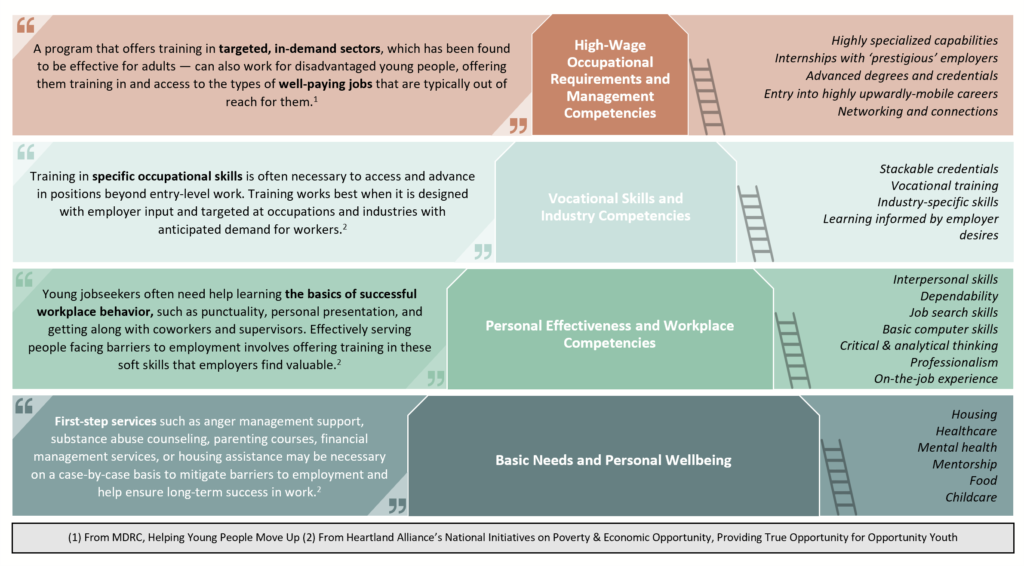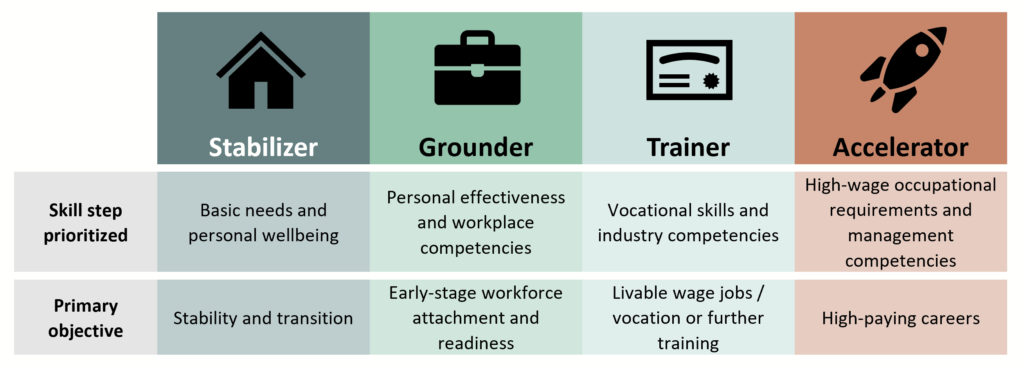Who are Opportunity Youth?
Opportunity youth (OY)—defined as individuals aged 16-24 who are neither in school nor in work—have become a focus of the national conversation on economic mobility for young people. 2020 Census data from the American Community Survey estimates that, of the 38 million 16-24-year-olds across the US, almost 5 million are OY.[1] This equates to more than 1 in every 8 youths nationwide being out of both school and work during a period of life that is critical for acquiring the skills and opportunities required for lifelong upward mobility.
Longstanding and systemic racial inequities in high-quality education access, employment opportunities, household stability, and justice system exposure mean that disconnection from work and school disproportionately affects BIPOC youth. Compared to non-Black youth, Black youth are 1.6 times more likely to be OY. [2] Similarly, both Native and Pacific Islander youth are 1.3 times more likely to be OY, and Hispanic youth are 1.1 times more likely to be OY, while white youth are 1.4 times less likely to be OY. Due to the heterogeneity of Asian Americans, inequities in youth connection to work and/or school are not visible on a group-level; however, youth identifying as Bangladeshi, Burmese, and Cambodian are more likely to be OY than the national average, highlighting the importance of disaggregating racial and ethnic categories.[3] On top of race and ethnicity, youth who report limited English skills[4] are 1.9 times more likely to be OY, while male youth and those residing in rural areas also face increased risk of disconnection.[5]
The issues faced by OY, and the implications of youth disconnection, are far-reaching and pertinent to diverse funders and service providers across the social sector. This is because OY aren’t just distinct from their in-school / in-work counterparts in terms of their educational and employment status; they are also typically experiencing other cross-cutting risk factors. For example, many OY are also navigating early parenthood, lack of health insurance, limited educational attainment—e.g., lack of secondary degree—, disability, and exposure to the penal and/or foster care systems.[6] Reconnecting OY to opportunities for advancement, as well as preventatively serving at-risk youth, is of critical importance to many different entities in the social sector with intersecting missions. As a result, community-based organizations, philanthropies, government initiatives and policymakers, national coalitions, and think-tanks across the country seek to help OY succeed in school and work to, ultimately, open the door to opportunity for all young people.
What do Opportunity Youth need to succeed?
In analyzing the landscape of organizations supporting opportunity youth nationwide, and in partnering with some of these organizations as strategic advisors, we have identified 4 sequential categories of needs that must be met in order for OY to experience upward economic mobility and thrive within the workforce:[7]
- Basic needs and personal wellbeing: housing, food, physical and mental health care, trusted adults, childcare
- Personal effectiveness and workplace competencies: interpersonal skills, job search and resume experience, basic computer and analytical thinking skills, dependability and professional
- Vocational skills and industry competencies: stackable credentials, vocational training, industry-specific skills, on-the-job experience in industry
- High-wage occupational requirements and management competencies: highly specialized capabilities, advanced degrees and credentials, networking and connections, access to highly upwardly mobile careers

Each step on this ladder provides the necessary foundation to enable the development of subsequent skills and competencies. For example, before a young adult can focus on showing up to work shifts on time and communicating effectively with a supervisor, it is important that they have a safe place to live and access to critical healthcare services. Similarly, refining vocational skills depends upon underlying interpersonal and workplace competencies that enable effective communication, learning, and working. Finally, industry-recognized credentials are often pre-requisites for OY to progress along upward career trajectories, as most do not have traditional 4-year degrees. This framework of needs required for upward economic mobility for OY acknowledges the barriers that these youth face and the importance of continuously establishing a strong foundation at each level to best position youth for success.
How can Opportunity Youth be best supported to climb the ladder?
When considering how to support OY along the path to upward economic mobility, it is helpful to return to this 4-step ladder. Given this wide range of needs—from emergency housing to advanced technical training—it is implausible and counter-productive for most organizations or programs to advance youth up every step of the ladder. Instead, it is more efficient and effective to develop a complementary ecosystem of organizations, each providing services to youth targeted at 1 or 2 steps of the economic ladder.
An MDRC analysis of different youth employment programs proposes two arguments in favor of this conceptualization of programs providing youth with support along different steps of the ladder.[8] First, they point to the relative brevity of most programs: “a 6- or even 12-month program is not enough to remove barriers to employment and education that have been years in the making.” By adopting distinct niches, programs can together provide youth longer-term support by “handing-off” youth along the scaffold as they move up the ladder, without implementing impractically long individual program durations. This approach also breaks down large and overwhelming hurdles for youth (e.g., challenges that may take over 5 years to fully address) into more approachable programs, thus lowering the risk of youth attrition.
The second argument put forth is that “any given program can only do so much.” It is unreasonable to expect that a given program could possess sufficiently broad and deep capabilities to specialize in serving youth at each step of the way. This is not to say that one organization could not offer a wide range of services—and in practice, many do—but rather that the guiding organizational objective should focus on just one or two steps on the ladder. Further, organizations targeting two steps of the ladder should ensure that their scope of services addresses two consecutive steps and does not omit an integral intermediate step. This approach allows programs and staff to become experts in the skills and knowledge required to deliver targeted and comprehensive support for youth at a given point on their progressive journey of economic mobility.
Through a landscape analysis of various programs involved in workforce development for OY and at-risk youth, we found most programs can be categorized as one of four archetypes, according to the step of the ladder that they prioritize for youth:

This framework for thinking about programs serving OY highlights the importance of each step, and thus each type of program. Work on either extreme of the ladder may more naturally provide the most visible or flashy impact stories (e.g., Stabilizers’ critical intervention during crisis or Accelerators’ immediate outcomes demonstrating high-paying jobs); however, the intermediate Grounder and Trainer roles are crucial in bridging the gap and bringing youth along from Stabilizer to, ultimately, Accelerator programs. By grounding services in the needs of OY, connecting specialized and focused programs in a broader ecosystem of scaffolded support, and valuing each step of the ladder to economic mobility, we can open doors of opportunity to OY for deep and sustained impact. For locally focused philanthropies and government entities, in particular, it pays to ensure that local investment is strategically planned so as to span the full spectrum of Stabilizer, Grounder, Trainer, and Accelerator service-providers, rather than picking a single OY-serving organization and expecting that organization to offer a full suite of services.
Not only are organizations playing each role—Stabilizer, Grounder, Trainer, and Accelerator—necessary in order to best serve OY; direct service organizations will also be most effective and efficient with their resources when they intentionally focus on 1-2 of these steps in the mobility ladder. Our advisory work has allowed us to test and confirm, first-hand, the reductions in cost per youth served that can be achieved over a multi-year period by strategically shifting to a more focused approach. Through refining a program’s objective, organizations will bring about both internal and external improvements, ultimately enabling greater impact for the youth they serve. Internally, prioritizing youth outcomes along 1-2 skill steps will streamline operations for codified and scalable program delivery; allow for greater specialization and deeper expertise; focus impact metrics and evaluation on most relevant youth outcomes; and guide staff and internal decisions. Externally, articulating organizational objectives in terms of the 4 archetypes creates a more cohesive story to obtain funding; incentivizes strong and intentional partnerships with other service providers; and clearly conveys the organization’s role in the broader ecosystem. These benefits will strengthen direct service providers individually, as well as the collective scaffolded support that they provide to OY.
[1] Analysis of 2020 ACS 1-year data
[2] Analysis of 2020 ACS 1-year data by dichotomous race/ethnicity variables
[3] Analysis of 2020 ACS 1-year data
[4] As compared to those who speak only English or who speak English well or very well
[5] Comparing those outside of a metropolitan area to those within
[6] Measure of America, A Decade Undone
[7] Inspired by and adapted from U.S. Department of Labor Employment & Training Administration’s tiered competency model (Competency Model Clearinghouse – Building Blocks Model (careeronestop.org))
[8] MDRC, Helping Young People Move Up
